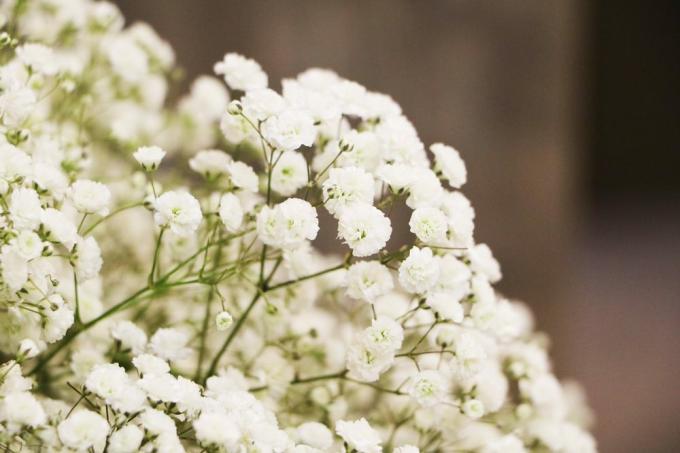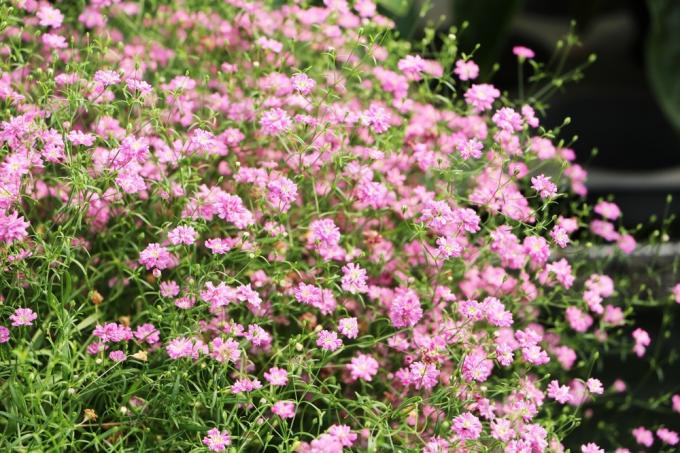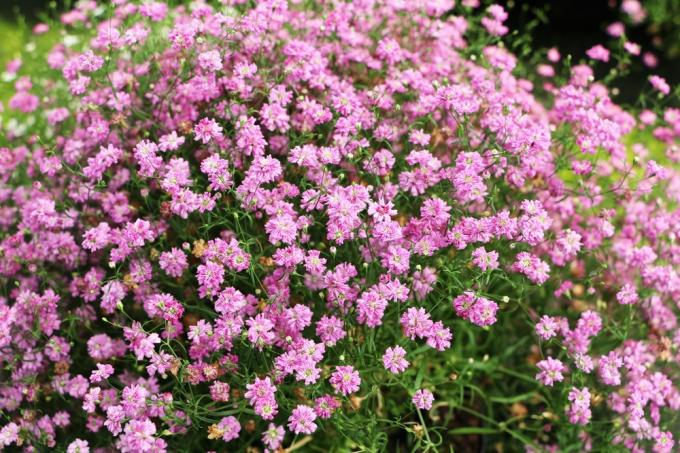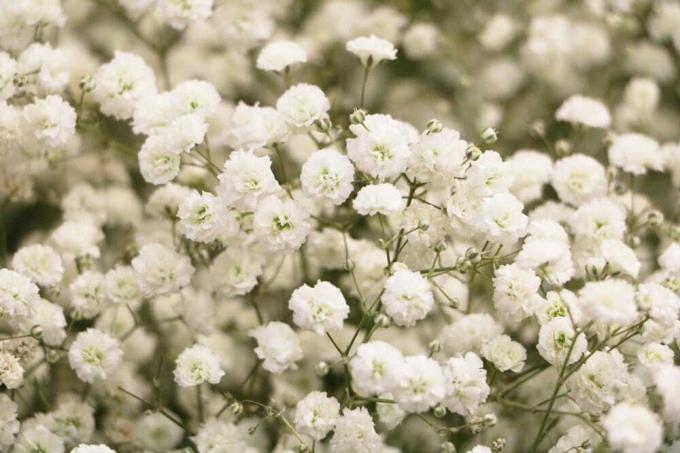
table of contents
- origin
- care
- Location
- Cut
- to water
- Fertilize
- Multiply
- Pests
- Diseases
- sorts
Profile and care information open +conclude -
- Flower color
- pink, white
- Location
- Partial shade, shady, sunny, full sun
- Heyday
- May June July August
- Growth habit
- flat-growing, overhanging, creeping
- height
- 50 to 120 cm
- Soil type
- sandy, gritty
- Soil moisture
- very dry
- PH value
- neutral
- Limescale tolerance
- Calcium tolerant
- humus
- low in humus
- Poisonous
- Yes
- Plant families
- Carnation Family, Caryophyllaceae
- Garden style
- Rock garden
With its delicate appearance, the gypsophila belongs next Roses probably one of the most charming plants. They not only adorn the bouquet in an extraordinary way, but also the flowerbed. The gypsophila transforms bald spots over a large area and can be combined with almost any flower. The hobby gardener has the choice between an upright growing and a creeping gypsophila, which is also known as the panicle of gypsophila.
origin
The Gypsophila is a typical Eastern European to Western Siberian plant that has also made its way to our latitudes. Here in Central Europe it can be found in Austria and also in Germany. The gypsophila feels particularly at home in Mecklenburg-Western Pomerania, Brandenburg and the Italian South Tyrol.

It chooses sandy hills to spread and naturally grows wild on the dry sand grassland. In our care instructions you will find all the important points for growing and caring for gypsophila.
care
Extremely filigree and at the same time a popular addition to the flower bed: the beautiful gypsophila. In our latitudes it grows rather low to medium high, in the American mountains it reaches heights of up to 1.20 meters. The small white flowers are then only topped by the nuances in pink.
And because it usually grows rather low, it is often referred to as carpet gypsophila in some regions. How to create and care for this beautiful plant in your garden is described in our clear instructions for nature lovers.
Location
The gypsophila primarily loves a sandy, warm soil. It is important that this is permeable and calcareous. The warmth is an important factor for thriving, which is why the gypsophila also likes to choose crevices or stony, dry locations.
So at least a partially shaded location should be chosen for planting. Also of importance: a place sheltered from the wind that does not damage the filigree plant from strong winds.
floor
With heavy, damp soils, you won't have luck with gypsophila. Therefore, prepare a really sandy soil, which can also contain small pebbles. These ensure that rainwater always runs off and the plants do not stand there with wet feet.
- The drier the better!
Walls or stone joints are ideal. The gypsophila will develop excellently here. If you are planning a rock garden or want to beautify unsightly walls, you will make the right choice with gypsophila. The earth should therefore be as nutrient-poor as possible.

Because of this, there will be no space next to it Flowering plants because they prefer nutrient-rich soils in contrast to gypsophila. If the soil does not contain enough lime, it should be enriched with a substrate.
If not available in your own garden, you should:
- a sandy place to be prepared
- full sun and with nutrient-poor soil
- do not plant in the flowerbed
Sowing and growing
After sowing, the seeds are only covered with a thin layer of soil. Then moisten with a water sprayer and keep moist. Alternatively, the seeds can also be sown in a seed tray with a lid or in the cold frame. In a bright and warm location, the seeds get an ideal microclimate for germination. Every now and then the bowl should be ventilated to prevent rot.
- as soon as the small plants have developed four to five leaves, they can be transplanted
- they either come now singly in small pots or in the open air
Planting time
The seeds of the gypsophila are annual and at the same time hardy. The seeds are sown directly outdoors in March or April. The very small seeds should not be sown too densely as each individual plant spreads as it grows.
Between April and May, the gypsophila can also be cultivated very well in the greenhouse before it is planted out. Except for periods of frost, almost every month is suitable to beautify the garden. So it is worthwhile to propagate gypsophila in your own hands.
When planting or transplanting, the space requirement plays a central role. The carpet's gypsophila, for example, forms a wide carpet over time, which is why the planting distance is approx. Should be 50 cm. Each plant receives approx. 25 cm to spread out.
Neighbors of gypsophila
With its individually sparse demands on the soil, the neighbors must be carefully selected. Spurflowers not only have similar requirements, but are also similar in their growth. Small, delicate plants with enchanting flowers can enrich the gypsophila bed very well.

Also Mediterranean herbs like sage lavender require little water and can be combined with each other. When the tall plants are tied together, they will not fall apart and make a beautiful picture.
Cut
Any cutting and propagation go hand in hand with gypsophila. Should it actually become necessary to cut the plants, the cut cuttings can be used for propagation. Either place as a neighbor in the rock garden next to the mother plant or in a small plant pot.
to water
The gypsophila makes it easy for you! Because here you don't have to worry about watering or fertilizing. On the contrary. In the case of long dry phases, moderate watering can help, provided that the rain has not already taken over.
Fertilize
No fertilization is used! The motto here is very clear: less is more!
Multiply
Propagation is very simple using seeds or cuttings. We have already discussed this option under the heading of cutting. Because as soon as you cut off some of the branches for a fresh bouquet, you can always propagate new cuttings. On the other hand, you collect the seeds and are well prepared for the next gardening year.

The annual gypsophila may spread itself with falling seeds. Because both the plant and the seeds are hardy. In late autumn you can use the cuttings to cover the need for new plants. The cultivation takes place in small plant pots with a sandy bottom.
This can be mixed with a small handful of potting soil to encourage root development. It is important that not too much is poured and that there is still a slightly damp climate under the film.
Overwinter
Wintering in our regions is difficult. On the one hand, this is due to the fact that many varieties are annual. On the other hand, the plants do not tolerate the very cold temperatures or frost. The winter months in particular are very humid, which is harmful to the plants. It is possible to cover the perennial plants with a mulch layer of dry leaves and brushwood. It can stay dry underneath and there is a good chance that the plants will sprout again in the next year.
Pests and diseases
Pests
The beautiful gypsophila is rarely attacked by pests. Every now and then aphid infestation can occur. Snails also seek out the young shoots in spring. These visitors should be collected quickly so that the plants are not eaten.

Diseases
Diseases are extremely rare in gypsophila. Dampness and wetness are the most common causes of stem rot or root rot. Therefore, the soil should be loosened with sufficient sand before planting. If rot actually develops, action is required more quickly, as otherwise the plants can die off quickly.
sorts
At second glance it becomes clear in what variety the gypsophila grows. Here we present an overview of the varieties of gypsum herb.
Gypsophila in pink
- Gypsophila repens "Letchworth" enchants with pink-red flowers, grows in width and only reaches a height of 10 cm, flowering time between May and July, ideal as a foreground planting
- Gypsophila repens "rose veil", delicate pink flowers, double at a low height of 10 cm, blooms for a very long time during summer
- Gypsophila repens "Rosea" in soft pink with a height of up to 25 cm and the flowering phase between May and July
- Gypsophila paniculata "Flamingo" with large, double pink flowers, with an impressive height of 120 cm, grows richly branched and blooms between June and August

- Gypsophila elegans appears in pink and white, reaches a height of between 30 - 50 cm, is very suitable as a cut or dried flower
Gypsophila in white
- Gypsophila aretioides belongs to the smallest gypsophila variety with a height of only 5 cm, it forms a white, attractive cushion that prefers warm and sunny wall crevices, also ideal for the rock garden
- Gypsophila repens "Compacta Plena" also a representative for the rock garden with a height of 20 cm, large, white double flowers, grows very densely
- Gypsophila paniculata "Festival Star" is the gypsophila with white flowers and a height of 40 cm, is very suitable for plant pots
- Gypsophila paniculata "Bristol Fairy", with double, white flowers and a stature height of up to 90 or 100 cm, blooms from the end of June
- Gypsophila pacifica convinces with very large, white flowers and a height of up to 100 cm, likes to grow in colder regions, very resistant

